Damnation Alley Landmaster
At RECOIL, we review every product fairly and without bias. Making a purchase through one of our links may earn us a small commission, and helps support independent gun reviews. Read our affiliate policy.
Find out more about how we test products.
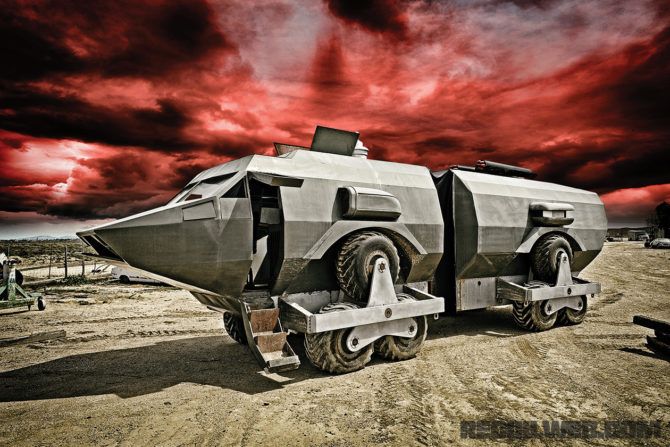
Tracking Down This Science Fiction Icon
Photos by Mark Saint
The Third World War left the planet shrouded in a pall of radioactive dust, under skies lurid and angry, in a climate gone insane. Tilted on its axis as a result of the nuclear holocaust, the Earth lived through a reign of terror with storms and floods of unprecedented severity. When this epoch began to wind down, the remnants of life once more ventured forth to commence the struggle for survival and dominance. This is the story of some of them.
If you recognize this passage, or the vehicle pictured here, then you know what movie it was from. If you don’t, what the hell’s the matter with you? Stop whatever you’re doing and go watch Damnation Alley.
You could count on two things if you grew up in the ’80s — the looming threat of exchanging nukes with the Soviet Union and reruns of old sci-fi flicks on TV. Sometimes those two things were intermingled. Released in 1977, Damnation Alley starred Jan-Michael Vincent, George Peppard, Paul Winfield, Dominique Sanda, and Jackie Earle Haley and was based loosely on the novel of the same name by Roger Zelazny. The movie tells of Air Force personnel at a nuclear launch site who survive Word War III and subsequently build two identical Landmaster vehicles to traverse the dangerous postwar landscape en route to Albany, New York, where they hope to find survivors. They encounter killer cockroaches, giant scorpions, hostile nomads, and violent storms along the way.
Damnation Alley was expected to be the big summer blockbuster, but didn’t get the fanfare it’d hoped for, largely overshadowed by the introduction of another sci-fi dynasty that’s still with us today (and getting worse with each sequel). In the years following the film’s lackluster release, television and a new industry called video rental helped it find a new audience, and it became a bit of an underground classic. Undoubtedly, the appeal of the movie wasn’t its premise, acting, or directing. It was the Landmaster — a marvel of engineering unlike anything attempted before.
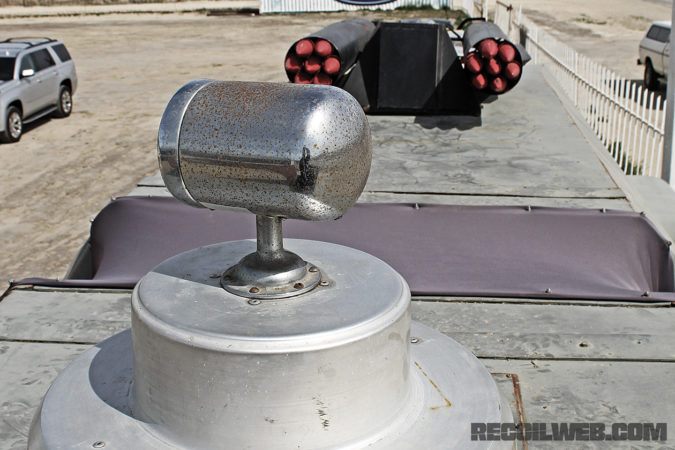
Although two vehicles were seen in the movie, only one was ever built and duplicated on film with some trick editing and scale models. The Landmaster was designed and created by famed stunt coordinator and car customizer Dean Jeffries, whose other work includes the Monkeemobile, moon buggy from Diamonds are Forever, and the Green Hornet’s Black Beauty. He even painted the words “Little Bastard” on the back of the Porsche Spyder James Dean was killed driving. While some of you may think George Barris built some of the aforementioned cars, we have it on good authority that isn’t true. Check out this interview with Jeffries: www.motortrend.com/news/c12-0511-dean-jeffries-interview/.
The Landmaster didn’t see much on-screen action after its debut. Aside from some unremarkable cameos, it became a bit of a local landmark and sat idly for many years in front of Jeffries’ shop next to the Hollywood Freeway, along with a few vehicles he built for another cult sci-fi film, Logan’s Run. The automotive icon eventually retired and passed away in 2013. Many of Jeffries’ vehicles ended up in the hands of private collectors, including the Landmaster.
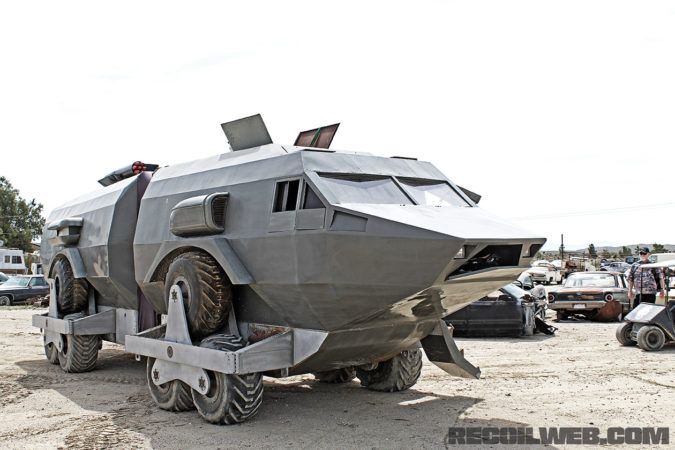
After it left Jeffries’ lot, little was known about the whereabouts of the Landmaster. For some strange reason many famous cars inexplicably disappear. Remember James Dean’s ill-fated Porsche we mentioned? Shortly after being displayed at a number of car shows not long after the actor’s death, it vanished and has never been found. Rumors about the Landmaster even suggested that Jesse James bought it with the intention of destroying it with a minigun on his show — thankfully that was just urban legend. It currently resides at another automotive icon’s shop, Gene Winfield, one of the pioneers of hot rodding. Winfield’s work has appeared in films like Blade Runner, the original RoboCop, and Back to the Future 2. Although Winfield doesn’t own it, he lets the current owner park it there, as the two have been longtime friends and are both hard-core gearheads.
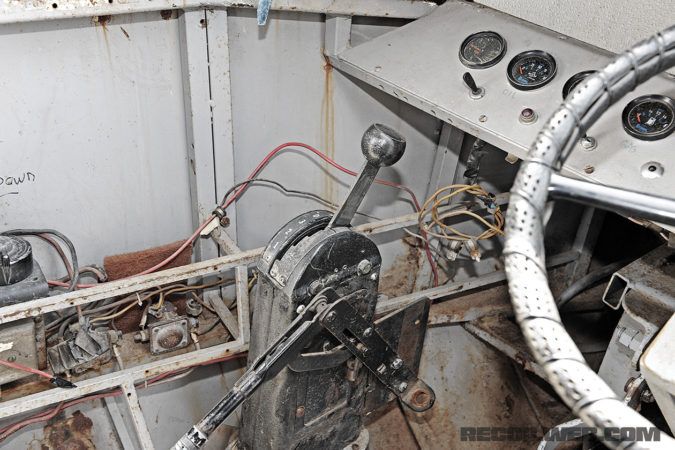
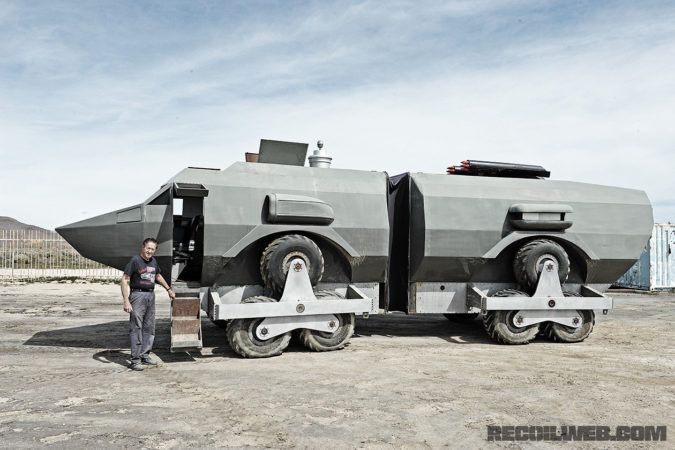
The Landmaster resides at Gene Winfield’s shop in Mojave, California. Well into his 90s, he’s still building hot rods.
To the best of the owner’s recollection, the vehicle’s chassis was built from scratch and originally designed by a military contractor in Texas as a missile transport, but was never used for that purpose, so it was offered to 20th Century Fox once preproduction on the film began. Jeffries was asked to draw up a body for it, and the studio liked his renderings. After agreeing on the concept, the chassis was shipped to Los Angeles and Jeffries got the gig to complete the vehicle. Total cost to build the Landmaster was around $500,000. You can see early photos of some of Jeffries’ builds including the Landmaster here: https://jalopnik.com/dean-jeffries-50-fabulous-years-in-hot-rods-racing-5328147.
Its construction is a combination of steel and aluminum, and articulates in the middle by way of a hydraulic drive, similar to what’s on an earthmover-type tractor. It stands just over 12 feet tall, is approximately 10 feet wide, and about 35 feet long. The two segments were originally connected by a neoprene sleeve during filming, which has since been replaced due to age. Because of its enormous size, it’s not street legal and has to be transported via flatbed. The interior is very sparse compared to the ’70s pseudo-scientific version seen in the movie, most of which was done on a set. At one time, actual machine guns were mounted in the rear section’s openings for various shots, but faux versions used for other scenes. The rocket launcher and cylindrical antenna on the roof are just props.
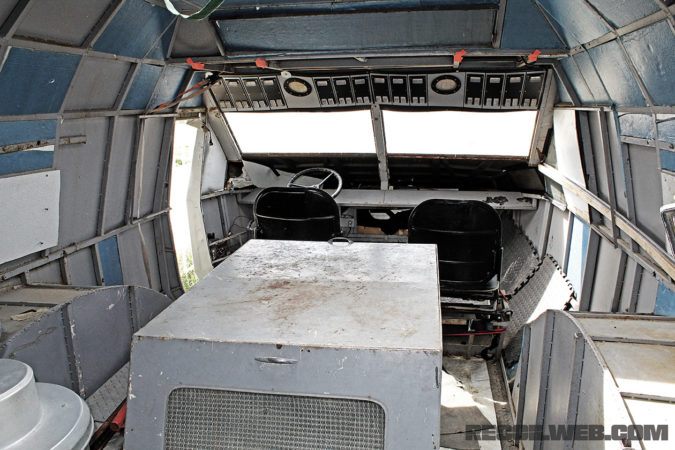
Not many photos of the Landmaster’s interior have been made public before. That box you see in the foreground houses the motor. A second steering wheel was installed to mimic the one on the passenger side seen in the movie, but has since been removed and never actually controlled the vehicle.
Powering this 18-ton beast is a 1974 391ci experimental Ford industrial engine tied to an Allison transmission. Jeffries had worked with Carroll Shelby on other projects, and the owner believes Shelby gave Jeffries the powerplant for this build. The motor is believed to be one of two made, both of which Jeffries had in his possession at one time. After Jeffries’ passing, it’s rumored that the second motor was inadvertently scrapped. Be that as it may, the Landmaster still fires up and runs just fine. The foam incorporated into its chassis does allow it to float as was seen on film. The tires are still the original 38×20-16.1 Goodyear Super Terra-Grips.
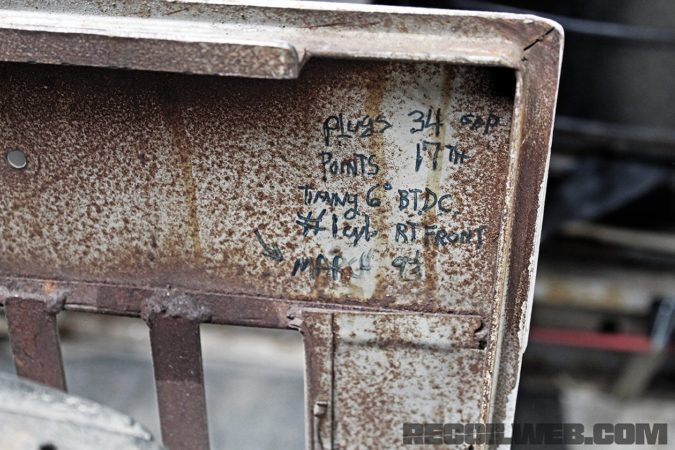
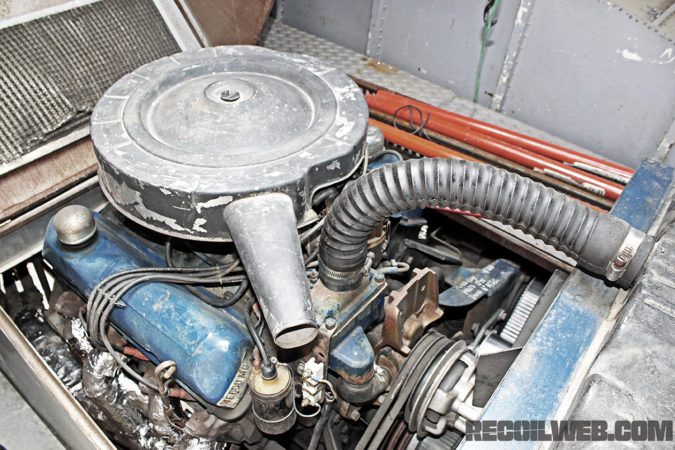
The Ford powerplant is probably much smaller than you expected. The specs etched on the housing are believed to be Dean Jeffries’ writing.
The tri-star wheel assemblies are truly works of art. Each one contains three wheels operated by a seven-gear drive system. The assemblies can be locked so eight wheels are making contact with the ground or unlocked, which allows the entire assembly to roll so it can climb over obstacles or “paddle” through water. “All three drive sources are independent of each other. It can drive, just like it says in the movie, with the front or rear axles out of commission,” the owner says. “It has a transfer case built into it, so it’s exactly like a 4WD, except the transfer case physically disconnects the rear axles from the front axles. All 12 wheels spin independently when it’s on the water and the actual tri-stars rotate. Top speed on the water is 8 knots.”
So how’d the current owner manage to take over this behemoth? He was headed down the Hollywood freeway on his way to Disneyland with his father when he was 10 years old and saw this rusting relic parked in front of Jeffries’ shop. Instantly enamored, and since they were stuck in typical L.A. traffic, he got out of his car, told his dad he’d be with “that truck,” and to come back and pick him up. He hopped over the fence and raced over to see this vehicle that piqued his curiosity.
Upon seeing him milling around the lot without permission, Jeffries came out of his shop, and with some curt words, told him to beat it. He told Jeffries he wanted to buy the Landmaster, offered him $1 on the spot to buy it, and managed to haggle Jeffries into a payment plan that lasted the next 26 years until he paid back every cent of the price they agreed upon. Apparently he was able to win over Jeffries with his smitten disposition. Over the years, he befriended Jeffries enough to begin working with him. He took possession of the vehicle not long before Jeffries’ death.
The owner plans a full restoration back to 1977 on-screen glory, and we’ll keep you updated once it’s returned to period-authentic condition. One can only guess if it’ll return in any sort of cinematic capacity. It seems that many movies of that era are now being remade since studio executives no longer have the backbone to try something original. Be that as it may, hopefully a portion of the box office revenue will go toward the calcium supplements they so desperately need.
Even though it’ll probably never be added to the National Film Registry, Damnation Alley harkens back to a time in Hollywood where special effects still required technical innovation. Feats like this hadn’t yet devolved into fudging everything with CGI. Watch it with your kids and tell them people actually used to build functioning vehicles like this for movies. Since it’s still drivable 40-some years later, we can’t help but wonder if the Landmaster really would survive the apocalypse.
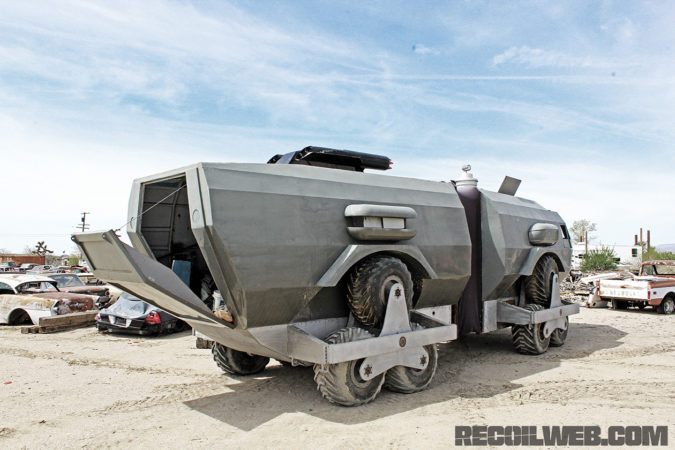
The two segments of the body are connected in the middle by a hydraulic actuator that turns the vehicle. The back was storing some random equipment and is essentially an empty shell. It never had a shower or bed as shown in the film. Jan-Michael Vincent was said to have smacked his head several times on the top of the rear opening while riding in and out on his motorcycle.
Landmaster
Built by Dean Jeffries
Motor: 391 Ford industrial engine
Transmission: Allison
Length: 35 feet
Weight: 18 tons
Top speed: 65 mph
Why you can trust RECOIL
Since our founding in 2012, RECOIL remains the premier firearms lifestyle publication for the modern shooting enthusiast. We deliver cutting-edge coverage of guns, gear, accessories and technology. We go beyond basic reviews, providing no B.S. buyer’s guides, hands-on testing and expert analysis on everything from firearms and survival equipment to watches and vehicles.
Our reviewers are the backbone of our operation and come from diverse shooting backgrounds: Former law enforcement, military veterans, competitive shooters, seasoned hunters and plain old firearms enthusiasts. Furthermore, we’re not just gun experts, but dedicated journalists who adhere to the strictest standards of our profession.
At RECOIL, editorial independence is the foundation of everything we publish and the cornerstone of reader trust. Our editors, writers and content creators make all editorial decisions independently, free from outside influence. That boils down to: advertisers don’t dictate our coverage, the outcomes of our reviews or what we recommend in our buyer’s guides. First and always, our commitment is to our audience—ensuring every review and article is accurate, unbiased, and driven by real-world experience.
Whether you’re selecting your next firearm, upgrading your gear, or exploring the latest innovations in the shooting world, RECOIL provides the trusted insights you need to make informed decisions. Learn more about our Editorial Standards and how we review products.

NEXT STEP: Download Your Free Target Pack from RECOIL
For years, RECOIL magazine has treated its readers to a full-size (sometimes full color!) shooting target tucked into each big issue. Now we've compiled over 50 of our most popular targets into this one digital PDF download. From handgun drills to AR-15 practice, these 50+ targets have you covered. Print off as many as you like (ammo not included).Get your pack of 50 Print-at-Home targets when you subscribe to the RECOIL email newsletter. We'll send you weekly updates on guns, gear, industry news, and special offers from leading manufacturers - your guide to the firearms lifestyle.
You want this. Trust Us.
4 Comments
Add a comment
View Comments
-
A big prop
-
Great article about a fantastic machine! Thanks for the research and memories!
-
wikipedia say this unit weighs 23,000 pounds and not 18 tons. Also the unit price was $350,000 to build and not the $500,000 as your artical states
-
I would like to know the source of the info for the weight and cost as well. It could very well be that Wikipedia is wrong. They are wrong a lot.


A big prop
Great article about a fantastic machine! Thanks for the research and memories!
wikipedia say this unit weighs 23,000 pounds and not 18 tons. Also the unit price was $350,000 to build and not the $500,000 as your artical states
I would like to know the source of the info for the weight and cost as well. It could very well be that Wikipedia is wrong. They are wrong a lot.